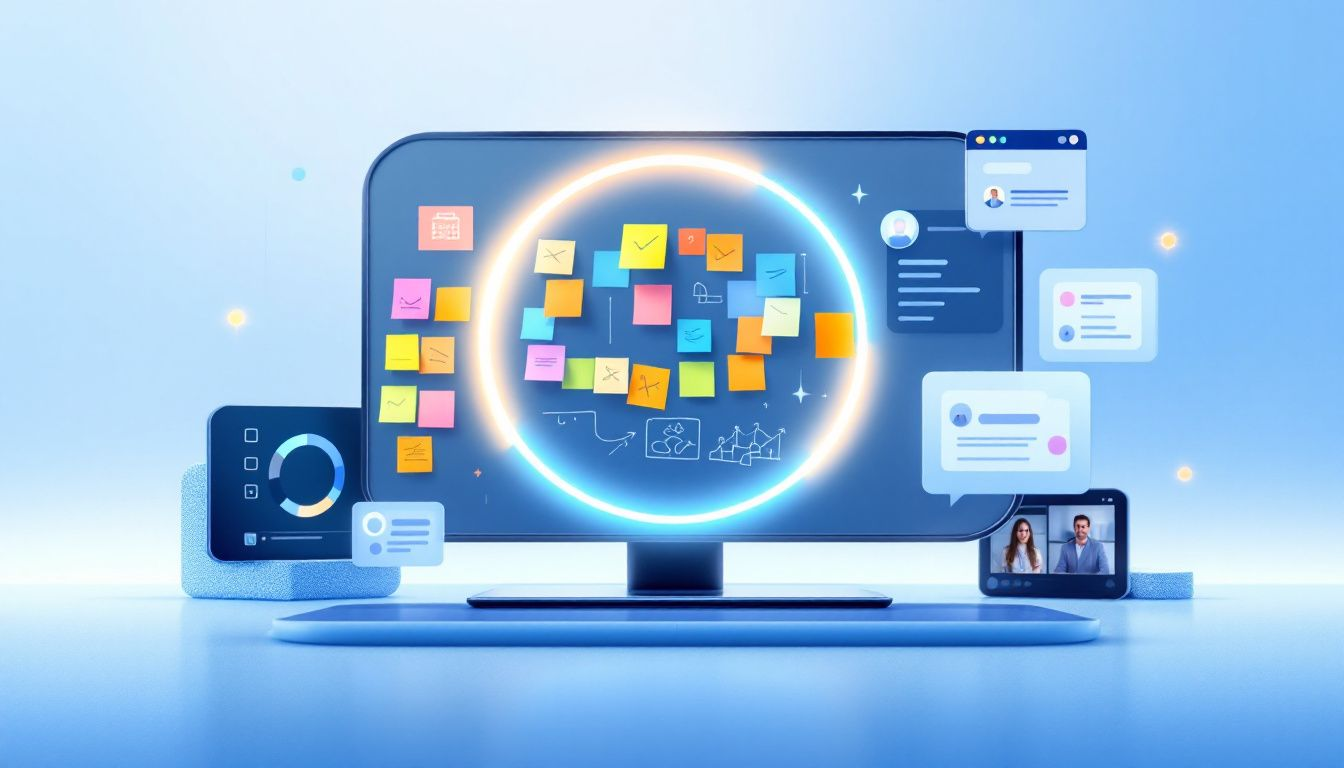In 2025, remote work demands more than just a laptop and internet connection. The growing trend of fully remote work options in the tech industry highlights the productivity benefits and flexibility these roles offer. To excel, your remote work tech setup 2025 needs to leverage the latest innovations in hardware, software, and connectivity. Read on to discover how to build a cutting-edge remote workspace that keeps you productive and comfortable.
Key Takeaways
- Investing in essential hardware and ergonomic solutions is vital for productivity and well-being in remote work settings.
- Choosing appropriate software tools and project management applications enhances collaboration and task management among remote teams.
- Maintaining work-life balance through established work hours, regular breaks, and continuous learning is crucial for remote worker satisfaction and productivity.
- Emphasizing career growth by providing access to resources and opportunities for continuous learning can foster a culture of lifelong learning, ultimately benefiting both employees and organizations in a rapidly evolving job market.
Current State of Remote Work
The current state of remote work is marked by its widespread adoption across various industries, with a significant shift towards remote or hybrid work models. According to recent statistics, approximately 28% of employees worldwide worked remotely in 2023, up from 20% in 2020. In the United States, about 22.8% of employees worked remotely at least part-time as of August 2024, translating to approximately 35.1 million people. This shift has proven to boost productivity for many organizations, with most employees reporting stable or increased productivity levels.
With 91% of employees preferring to work fully or almost completely remotely, companies are adapting to this growing preference by implementing flexible work arrangements. This trend is reshaping the traditional office environment, leading to a more dynamic and adaptable workforce. As remote work continues to evolve, businesses are finding innovative ways to support their remote employees, ensuring they remain productive and engaged.
Essential Hardware for Remote Work

Having the right tools is crucial for a productive and efficient remote work environment. Skilled remote workers may find their productivity hampered if they lack the appropriate equipment. As remote work trends continue to develop, it’s important to invest in necessary hardware that contributes to an effective workspace. The rapid growth of remote tech positions further underscores the need for appropriate hardware to support these roles.
Incorporating multiple monitors into a remote workstation is integral as they offer expanded visual real estate for multitasking, which can substantially boost productivity by enabling employees to handle various tasks at once. Ergonomic setups—including adjustable chairs and desks capable of transitioning between sitting and standing—are vital for maintaining comfort and health. These elements support improved posture and minimize the dangers associated with extended periods of sitting, safeguarding well-being during lengthy hours of work.
To establish a professional-grade and high-performance home office space requires meticulous consideration of each piece of hardware. Blending ergonomic advancements with contemporary remote working trends enhances your ability not only to remain productive, but also ensures overall wellness as you excel in your off-site job roles.
Choosing the Right Software Tools
Choosing appropriate digital tools is just as essential as selecting the right physical equipment. These technologies form an integral part of your operational flow, facilitating smooth teamwork and effective task execution. For individuals in tech roles, possessing both technical skills and access to suitable digital platforms are vital for maintaining efficiency and connectivity when working remotely. Additionally, digital platforms are crucial for job searching and networking, especially in the burgeoning market for remote tech jobs.
Software like Quire enables meticulous organization through its infinite nested lists feature, aiding in the management of tasks on a solo basis or within group settings. Wrike offers capabilities such as proofing workflows and intelligent recommendations that cater to projects of varying scopes, thereby boosting productivity levels across the board. Zoho Projects integrates elements similar to social media platforms which enhance interaction and cooperative efforts among members of remote teams.
Incorporating these technological solutions into regular work routines simplifies job responsibilities while bolstering coordination amongst colleagues – resulting in a productive synergy even from afar. By utilizing optimal project oversight systems along with collaboration-enhancing applications, those employed remotely can adeptly prioritize their workload, allocate assets efficiently, and sustain peak performance standards.
Remote Access and Support Technologies
Remote access and support technologies are revolutionizing the way remote teams collaborate and operate. By 2025, businesses will prioritize tools that ensure seamless, secure connectivity to devices and systems, regardless of location. Modern remote access solutions now offer features like multi-device compatibility, enhanced security protocols, and real-time monitoring. These technologies enable employees to securely access their office desktops, applications, and files from any device, ensuring uninterrupted productivity.
With the rise of remote work, companies are investing in robust remote access and support solutions to maintain business continuity and employee satisfaction. These tools not only facilitate efficient workflows but also provide the necessary security measures to protect sensitive data. As remote work becomes more prevalent, the demand for reliable and secure remote access technologies will continue to grow, shaping the future of remote collaboration.
High-Speed Internet and Connectivity Solutions
A robust and swift internet connection is crucial for remote workers, serving as the backbone that enables immediate dialogue and efficient utilization of cloud-based services. These elements are pivotal in fostering unimpeded virtual communication and collaboration among tech professionals.
Equipping oneself with both a primary high-speed internet source along with a fallback option minimizes work interruptions should an outage occur, thereby sustaining productivity levels and adherence to project timelines regardless of connectivity issues.
As technological progress simplifies the process for remote workers to remain connected, it’s still vital to invest in internet solutions specifically designed for the demands of remote work. This investment ensures that collaboration tools and cloud services perform at their peak, promoting an effective and cohesive working environment from afar.
Setting Up a Dedicated Workspace in Remote Work Environments

Establishing a specific area for work is critical to enhancing your remote work experience. This dedicated space aids in concentration and sets a clear delineation between professional tasks and personal activities, which is essential for preserving an equilibrium between work and life. For individuals working remotely, using this designated area exclusively for occupational duties assists in mentally detaching from work when the day ends.
It’s also vital to carefully select where you set up your home office. Choosing a spot that minimizes interruptions while maximizing exposure to natural light can greatly increase both productivity and overall well-being. Ensuring that this workspace remains tidy and free of clutter at the conclusion of each business day sets the stage for an efficient commencement of activities on the following morning, facilitating a smooth shift into professional responsibilities.
Lastly, incorporating ergonomic pieces such as a comfortable chair or adjustable standing desk mitigates physical strain during extensive hours spent working, aiding in maintaining comfortability and focus throughout the day. Personalizing your workstation with items like vegetation or artwork creates an aesthetically pleasing environment which not only makes it more welcoming but also serves to enhance productivity within your remote working habitat.
Cybersecurity Best Practices to Protect Sensitive Data for Remote Workers
As the prevalence of remote work continues to rise, maintaining robust cybersecurity is of paramount importance. It’s vital to shield sensitive information from potential threats inherent in remote work settings. Placing data securely in one centralized location minimizes the likelihood that cybercriminals will gain access to it, which is a critical strategy for those working remotely.
By leveraging Desktop as a Service (DaaS), organizations can host their sensitive information within a unified center, diminishing the dangers posed by storing data on local devices. Employing standardized hardware equipped with security enhancements allows firms to more effectively navigate and control risks associated with remote workplaces while providing secure conditions for individuals working from afar. Advanced protective measures such as multi-factor authentication play an indispensable role in securing data and upholding the sanctity of environments dedicated to remote work.
Developing explicit protocols related both to remote employment and specific practices like Bring Your Own Device (BYOD) is instrumental in defending against breaches involving confidential information. The education of remote staff members about fundamental cybersecurity strategies cannot be understated—lapses in training could increase susceptibility to unauthorized infiltrations into systems holding delicate records. By giving precedence to rigorous cybersecurity initiatives, workers operating at a distance are empowered not only towards safeguarding highly sensitive data but also fostering an overall secure virtual workplace framework.
Virtual Collaboration Tools

By 2025, it is anticipated that the use of virtual reality and augmented reality (AR) in facilitating remote collaboration will significantly improve how team members interact and communicate. Virtual environments for meetings are poised to offer realistic discussions, connecting people across distances more effectively and bolstering joint efforts. As VR and AR hardware become more cost-effective, these innovations will be within reach for a larger number of remote workers seeking improved collaborative experiences.
For optimal clarity during video calls in virtual gatherings, high-quality webcams are essential—they ensure communications remain clear-cut. Cloud storage solutions play an integral part in supporting remote work by providing secure platforms for storing and exchanging files seamlessly. Consistently reliable internet connections serve as the backbone for worldwide teamwork by linking individuals from various regions together into one cohesive unit capable of effective virtual communication.
To combat feelings of seclusion among distant workers, participating in activities designed specifically for virtual teams can help nurture camaraderie while strengthening collective unity within groups. With cutting-edge tools dedicated to virtual collaborations at their disposal, employees working remotely have the opportunity to sustain productive interactions with colleagues without being hindered by geographical constraints.
Automating Your Workflow
The incorporation of automation and AI into remote work has significantly boosted productivity by refining workflow processes and improving teamwork capabilities. These advancements empower those working remotely to concentrate on tasks that add more value while anticipating potential impediments, thus enabling the seamless advancement of projects. The decrease in manual operations resulting from automated workflows leads to fewer hold-ups and bolsters efficiency.
In terms of altering remote work environments, workflow automation serves as a game-changer by lessening the burden of monotonous activities such as organizing calendars and inputting data. Automation systems adeptly handle documents, taking care of invoice distribution or keeping track of approvals systematically to ensure precision and timeliness in task execution. Applications designed for managing tasks facilitate an organized approach to handling assignments while simultaneously tracking project milestones effectively, which drives up productive output.
Leveraging AI-oriented platforms delivers tailor-made analyses intended to aid staff members in better regulating their duties thus making them more efficient contributors within cooperative settings tailored for remote workers. By adopting these technological innovations that streamline how work is managed daily, individuals engaged in off-site employment can fine-tune their operational methods leading to heightened overall efficacy in their roles.
Remote Work Trends and Predictions
Remote work trends and predictions for 2025 indicate a continued shift towards hybrid work models, increased use of AI and automation, and a focus on employee well-being and mental health. By 2025, 70% of the global workforce will be working remotely at least five days a month, and companies will invest heavily in cybersecurity measures to protect remote workers. Virtual reality (VR) and augmented reality (AR) technologies will become more prevalent in remote collaboration, offering immersive and interactive experiences that enhance teamwork and communication.
Businesses will prioritize tools that ensure seamless, secure connectivity to devices and systems, enabling remote employees to work efficiently from any location. Additionally, the growing demand for sustainable practices will lead companies to focus on reducing their environmental impact through eco-friendly remote work practices. These trends highlight the evolving landscape of remote work, emphasizing the need for adaptability and innovation in the tech industry.
Employee Well-being and Mental Health
Employee well-being and mental health are becoming increasingly important in the remote work landscape. With remote work becoming more widespread, businesses are recognizing the importance of prioritizing employee well-being and mental health. By 2025, organizations will focus on creating supportive environments that foster a healthy work-life balance for their teams. Companies are addressing this by introducing wellness initiatives, such as flexible schedules, mental health resources, and regular virtual check-ins.
With the rise of remote work, companies are investing in reskilling and upskilling initiatives to ensure employees remain adaptable and proficient in new tools and processes. These programs will focus on equipping employees with both technical skills and soft skills to thrive in virtual settings. By prioritizing employee well-being and continuous learning, businesses can create a more engaged and productive remote workforce, ensuring long-term success in the evolving world of remote work.
Maintaining Work-Life Balance

The challenge of achieving a work-life balance is significant for remote employees. Establishing and sticking to designated working hours can help delineate professional responsibilities from personal time, thus minimizing stress and preventing exhaustion. The flexibility provided by internet connectivity plays a crucial role in allowing remote workers the ability to navigate their personal and business needs effectively, thereby increasing both job satisfaction and output.
It’s beneficial for employers to support their workforce in taking breaks to rejuvenate, as it boosts overall productivity and employee wellness. By granting flexible scheduling options and access to mental health support such as therapy services or well-being programs, companies aid remote staff members in maintaining an equilibrium between work demands and life activities. Incorporating periodic pauses into the daily routine is essential for preserving not just productivity levels but also mental stability, which keeps those who work remotely committed and driven.
Investments made by organizations towards nurturing the welfare of their personnel are likely going to lead to heightened focus on averting burnout while safeguarding operational efficiency. Prioritizing a harmonious blend between career obligations and leisure pursuits enables individuals employed remotely not only excel at what they do, but also experience rewarding lives outside of work.
Continuous Learning and Upskilling
Maintaining competitiveness in the tech sector requires a dedication to ongoing education and skill enhancement. Cultivating a mentality focused on growth through persistent learning contributes to both personal contentment and an eagerness for intellectual exploration. Advancing existing abilities, known as upskilling, alongside gaining new competencies for varying job functions through reskilling is fundamental for career progression within remote technology positions. Continuous learning and upskilling not only enhance current skills but also significantly contribute to career growth in remote tech positions.
Due to rapid technological changes, it’s projected that by 2025 nearly half of all workers will need to undertake reskilling. Convenient online programs provide opportunities for individuals to obtain relevant skills and credentials without interrupting their current employment status, facilitating easier adaptation amidst evolving roles influenced by automation and AI developments.
Lifelong learners are often regarded as top contenders for higher-ranking jobs, including management roles, because they continuously enhance their professional value within organizations. By making continuous learning and skill advancement a priority, remote professionals can keep pace with technological shifts while maintaining their edge in the dynamic world of remote employment.
This dedication towards ongoing professional development secures the ability of remote staff members to effectively manage future challenges associated with exclusively remote or hybrid work environments.
Sustainable Remote Work Practices

The transition to remote work has ushered in a variety of environmental advantages. The decrease in daily travel has markedly reduced carbon emissions, aiding the push towards a more sustainable planet. Shifting away from traditional office settings conserves energy by decreasing the demand for powering large corporate facilities.
As people work remotely, there is less reliance on abundant office supplies, which results in lowered waste production. Advocating for home-based workers to adopt energy-saving appliances and habits contributes to maintaining reduced levels of energy usage, bolstering eco-friendly efforts. Businesses also benefit financially from supporting remote work as it cuts down on utilities and upkeep expenses for physical offices, freeing up funds that can be directed into sustainability projects.
Embracing digital files reduces paper consumption significantly and supports ecological preservation. By integrating these green practices, both individuals working remotely and their employers play an essential role in fostering an environmentally responsible future while ensuring the lasting appeal and conscientiousness of telecommuting options.
Summary
To enhance your remote work environment, it’s essential to integrate appropriate hardware and software, secure internet connections, and robust cybersecurity protocols. Establishing a specific area for work while preserving the equilibrium between professional duties and personal life is vital for maintaining both productivity and personal health. The commitment of remote workers to continual learning along with eco-friendly practices elevates their experience in telecommuting, positioning them as competitive participants who are also mindful of their ecological footprint. Utilizing remote job boards can significantly enhance job prospects by providing access to thousands of job postings daily, especially for tech roles.
Remote employees can flourish in this capacity by following these guidelines—achieving satisfaction in both their careers and private lives while also contributing positively toward ecological sustainability. Seizing the benefits that come with telecommuting positions one well within an evolving digital workspace where staying current on trends is key to prospering in the dynamic world of remote employment.
Frequently Asked Questions
Why is having multiple monitors important for remote work?
For remote work, the use of several monitors is vital because it boosts productivity by providing extra display area for handling multiple tasks simultaneously and managing them effectively.
The arrangement facilitates a more structured approach to work processes and augments concentration.
What are some essential software tools for remote work?
In remote work environments, leveraging project management applications like Quire, Wrike, and Zoho Projects is crucial for boosting team productivity and enabling better collaboration.
Employing these platforms can markedly elevate the effectiveness and intercommunication of your team.
How can remote workers ensure reliable internet connectivity?
Remote workers need to secure high-speed internet access and establish a secondary connection as a safeguard against possible interruptions.
Taking such preventive measures is essential to preserve work efficiency in the event of connectivity failures.
What are the key benefits of continuous learning and upskilling?
Continuous learning and skill enhancement lead to greater personal fulfillment, career advancement, and increased competitive edge. These attributes are especially significant when adapting to novel positions that arise from technological progress.
Lifelong education equips people with the tools necessary for triumph in a constantly changing employment landscape.
How does remote work contribute to environmental sustainability?
By allowing employees to work remotely, environmental sustainability is notably enhanced as it decreases the amount of carbon released due to less commuting, saves energy and lowers the use of resources typically needed in an office environment.
Adopting remote work contributes to a decrease in waste generation and promotes a more eco-friendly Earth.
Leave a Reply